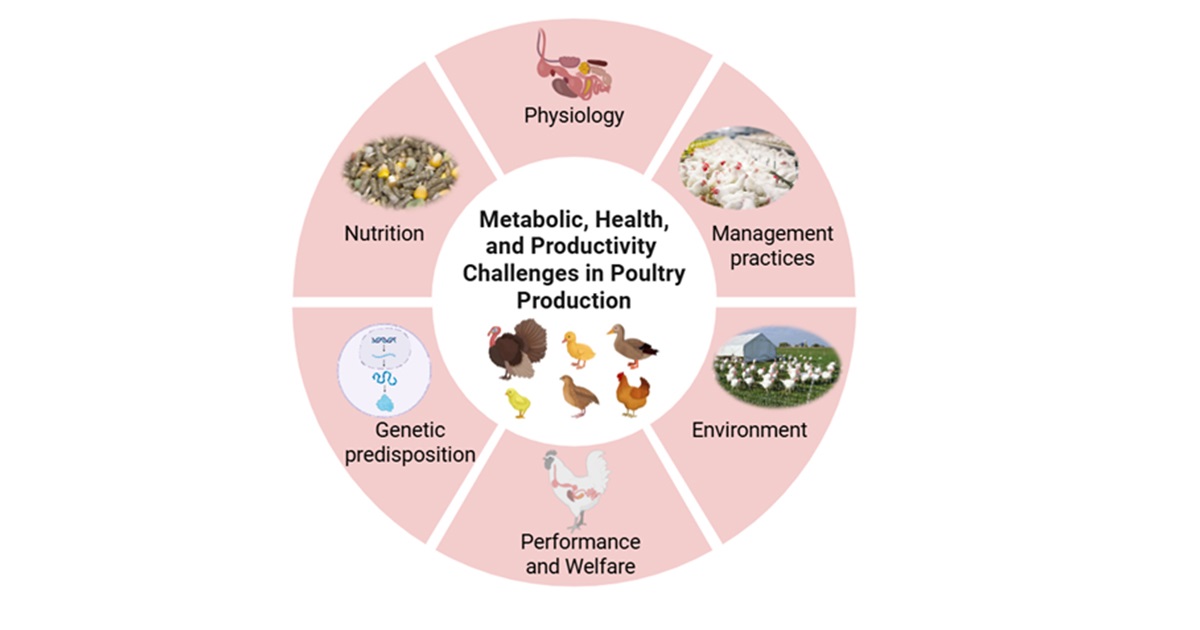Metabolic, Health, and Productivity Challenges in Poultry Production
A special issue of Animals (ISSN 2076-2615). This special issue belongs to the section "Poultry".
Deadline for manuscript submissions: 31 October 2026 | Viewed by 5038

Image courtesy of BioRender.com
Special Issue Editors
Interests: animal production; poultry nutrition; environmental physiology; gut health, immunology; alternative feed ingredients; nutrient metabolism
Interests: animal physiology; animal nutrition; animal reproduction; animal genetics and breeding; animal welfare
Special Issues, Collections and Topics in MDPI journals
Special Issue Information
Dear Colleagues,
Modern poultry production systems are characterized by rapid growth rates and high production efficiency, which, while economically beneficial, often predispose birds to various metabolic disorders and physiological imbalances. Over the last few decades, the incidence of metabolic disorders in poultry production has increased, accounting for huge economic losses in the poultry industry. Conditions such as ascites, fatty liver syndrome, sudden death syndrome, and skeletal disorders are becoming increasingly prevalent, raising concerns about animal welfare, economic losses, and the sustainability of poultry production.
These disorders are not related to infectious diseases; rather, they occur due to dysfunctions in metabolic processes, including the inability of the body to keep up with the demand for an increased metabolism, rapid growth rate, or higher egg production, resulting in morbidity and/or mortality. However, implementing appropriate modifications to the environment, nutrition, and managerial needs of poultry can help ameliorate these events. This heightens our need to understand the complex interactions between nutrition, physiology, environment, and management practices that influence the performance, health, and welfare of poultry.
This Special Issue aims to collate original research and review articles addressing existing and emerging challenges to poultry metabolism, health, and productivity. We welcome submissions that investigate the physiological, nutritional, genetic, and environmental factors contributing to metabolic and physiological imbalances in poultry species. Topics of interest for this Special Issue include, but are not limited to the following:
- Genetic and physiological mechanisms underlying metabolic disorders in poultry.
- Nutritional strategies to prevent and mitigate metabolic syndromes in poultry.
- Impacts of oxidative and heat stress on poultry health, performance, and metabolism.
- Understanding of the gut health and microbiome dynamics under health and metabolic conditions.
- Precision feeding and sustainable initiatives to improve poultry health and productivity.
- Environmental and managerial strategies to enhance the resilience and welfare of poultry.
- Development of early detection, health monitoring, and diagnostic tools for poultry.
This Special Issue seeks to foster a comprehensive understanding of the multifactorial nature of metabolic challenges in poultry and further explore the underlying mechanisms driving these challenges. It also encourages the development of innovative strategies to mitigate these issues, ranging from dietary interventions, environmental modifications, genetic strategies, and health-monitoring technologies. By addressing these multifactorial challenges, the research aims to support the development of resilient, efficient, and welfare-friendly poultry production systems that can meet the growing global demand for animal protein.
We invite you to share your recent findings in this Special Issue.
Dr. Victoria Anthony Uyanga
Dr. Felix Kwame Amevor
Guest Editors
Manuscript Submission Information
Manuscripts should be submitted online at www.mdpi.com by registering and logging in to this website. Once you are registered, click here to go to the submission form. Manuscripts can be submitted until the deadline. All submissions that pass pre-check are peer-reviewed. Accepted papers will be published continuously in the journal (as soon as accepted) and will be listed together on the special issue website. Research articles, review articles as well as short communications are invited. For planned papers, a title and short abstract (about 250 words) can be sent to the Editorial Office for assessment.
Submitted manuscripts should not have been published previously, nor be under consideration for publication elsewhere (except conference proceedings papers). All manuscripts are thoroughly refereed through a single-blind peer-review process. A guide for authors and other relevant information for submission of manuscripts is available on the Instructions for Authors page. Animals is an international peer-reviewed open access semimonthly journal published by MDPI.
Please visit the Instructions for Authors page before submitting a manuscript. The Article Processing Charge (APC) for publication in this open access journal is 2400 CHF (Swiss Francs). Submitted papers should be well formatted and use good English. Authors may use MDPI's English editing service prior to publication or during author revisions.
Keywords
- poultry
- metabolic disorder
- skeletal disorders
- nutritional deficiencies
- heat stress
- ascites
- sudden death syndrome
- fatty liver hemorrhage syndrome
- nutrition
- welfare
Benefits of Publishing in a Special Issue
- Ease of navigation: Grouping papers by topic helps scholars navigate broad scope journals more efficiently.
- Greater discoverability: Special Issues support the reach and impact of scientific research. Articles in Special Issues are more discoverable and cited more frequently.
- Expansion of research network: Special Issues facilitate connections among authors, fostering scientific collaborations.
- External promotion: Articles in Special Issues are often promoted through the journal's social media, increasing their visibility.
- Reprint: MDPI Books provides the opportunity to republish successful Special Issues in book format, both online and in print.
Further information on MDPI's Special Issue policies can be found here.







